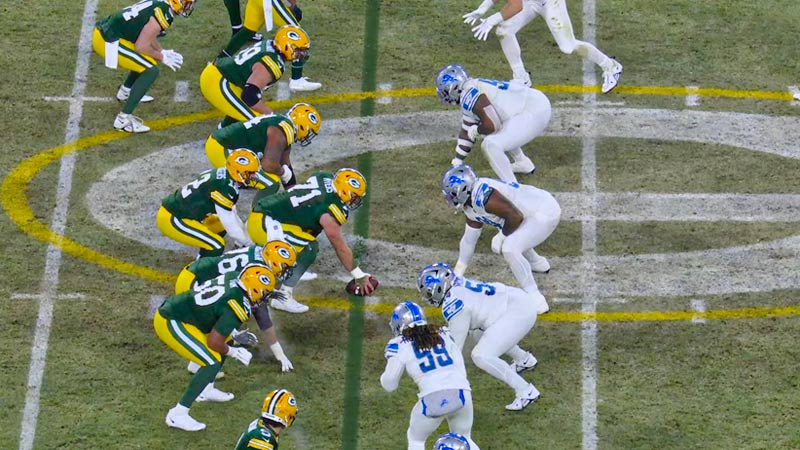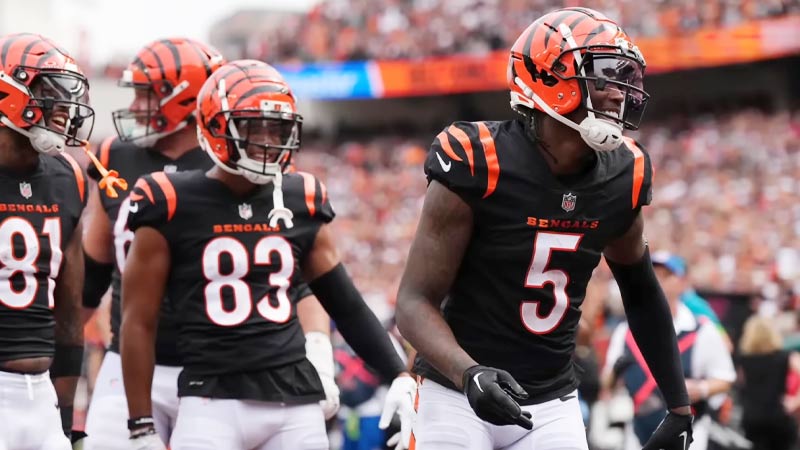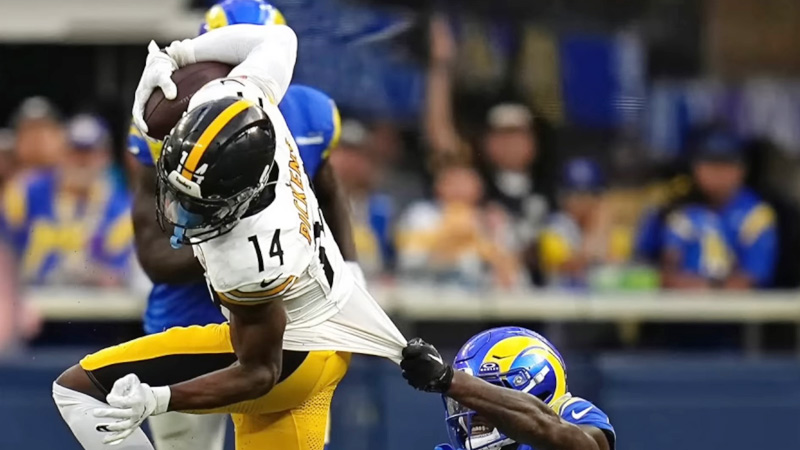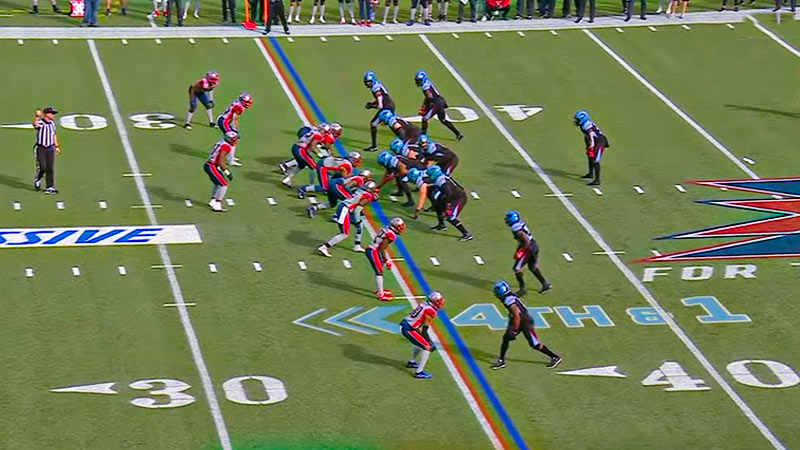Unlocking the complexities of American football involves delving into the intricate world of football offensive formations.
Each configuration shapes the game’s strategic landscape from the classic I-formation to the revolutionary spread offense.
This blog explores the evolution of offensive formations, dissecting their purposes, the impact of player skills, and the constant chess match against opposing defenses.
Discover how coaches tailor formations to their team’s strengths, the rise of innovative strategies like the spread offense, and the historical shifts that have defined the game.
As we explore the dynamic interplay between offense and defense, we unveil the playbook’s secrets, shedding light on the fascinating evolution that has propelled American football into a strategic spectacle. So, stay sharp.
Basics of Football Offense Formations
In American football, offensive formations dictate the positioning of players before the snap. The “I-formation” features a running back behind the quarterback, providing versatility.
The “shotgun formation” has the quarterback positioned farther from the center, offering better passing vision. The “spread offense” widens players across the field, fostering a dynamic passing game.
The “single-wing formation” is characterized by a direct snap to the quarterback, fostering diverse plays. Finally, the “pro set” involves a balanced formation with two running backs, combining both running and passing options.
Teams strategically choose formations based on their strengths, opponent analysis, and game situations.
Key Components of American Football Offense Formations
American football offense formations are strategic arrangements of players designed to optimize plays and exploit opponents’ weaknesses.
These formations vary widely, each serving specific purposes within the game.
Quarterback Positioning
The placement of the quarterback is crucial. In the “shotgun formation,” the quarterback stands farther from the center, providing a better view of the field for passing plays, while the “under-center” formation offers a quicker exchange for running plays.
Backfield Configuration
The arrangement of running backs and fullbacks influences the ground game. The classic “I-formation” places a running back directly behind the quarterback, allowing for versatile rushing and passing options.
Receiver Spreading in Spread Offense
The “spread offense” widens the formation, deploying receivers across the field.
This forces defenses to cover more ground, creating opportunities for open passes and exploiting one-on-one matchups.
Tight End Utilization
Some formations include a tight end position on the offensive line. This player can contribute to both blocking and receiving, adding flexibility to the team’s strategy.
Formation Adjustments for Specialized Plays
Coaches often tweak formations to suit specific plays or exploit an opponent’s weakness. Flexibility allows teams to adapt to various game scenarios and defensive schemes.
Popular Football Offense Formations
Football offense formations are crucial in shaping a team’s strategy and executing plays effectively. Several popular formations have become synonymous with different playing styles and strengths.
Spread Offense

Widely used in modern football, the spread offense involves deploying multiple receivers across the field.
This formation aims to stretch the defense horizontally, creating mismatches and open spaces for both passing and running plays.
I-Formation
A classic and versatile formation, the I-formation places the quarterback under center with a running back directly behind.
This setup allows for a balanced attack, combining power running and passing options, making it a staple in many playbooks.
Shotgun Formation
This formation has the quarterback positioned a few yards behind the center, offering better field visibility.
Popular for passing plays, the shotgun gives the quarterback more time to read the defense and make quick decisions.
Pro Set Formation
Featuring two running backs aligned behind the quarterback, the pro set provides a balanced approach with options for both running and passing.
It offers flexibility and keeps the defense guessing about the play’s direction.
Wishbone Formation
Known for its strong ground game, the wishbone formation involves a fullback and two halfbacks forming a Y-shape in the backfield.
It’s effective for running the ball and maintaining ball control, making it a choice for teams emphasizing a dominant rushing attack.
Tailoring Formations to Teams and Players

Tailoring offensive formations to a team’s unique strengths and players’ skill sets is a crucial aspect of strategic coaching in American football.
This customization ensures optimal performance and maximizes the team’s potential.
Utilizing Quarterback Skills
Coaches may tailor formations to leverage the specific strengths of their quarterbacks.
A spread offense might be preferred for a quarterback with exceptional passing accuracy, while a quarterback with strong rushing abilities might thrive in an option-based or shotgun formation.
Adapting to Running Back Talents
Tailoring formations involves considering the strengths of running backs.
A power runner may excel in an I-formation, while a more agile and elusive back might be better suited for a spread offense that creates open spaces.
Receiver Specialization
Formations can be adjusted to capitalize on the skill sets of wide receivers.
Teams with a dominant deep threat may favor formations that allow for longer passing routes, while others might prioritize quick, short passes with agile receivers in spread formations.
Incorporating Tight Ends
Teams with skilled tight ends may modify formations to feature them prominently, using their abilities in both blocking and receiving.
This strategic adaptation can create mismatches against opposing defenses.
Exploiting Offensive Line Strengths
Customizing formations involves aligning with the strengths of the offensive line.
Whether it’s a strong and powerful line for effective run blocking or an agile line for pass protection, the formation should complement and amplify these attributes.
Challenges in American Football Offense Formations
Crafting effective offensive formations in American football comes with its share of challenges as coaches grapple with various factors that can impact the success of their strategies.

Defensive Adjustments
One major challenge is the ability of opposing defenses to adapt.
As offensive formations are revealed, opposing coaches may make quick adjustments to counteract the intended strategy, requiring constant innovation to stay ahead.
Injuries and Player Changes
The dynamic nature of football, coupled with the game’s physicality, means that injuries and player changes are inevitable.
Coaches must adjust formations to accommodate new personnel and maintain optimal performance despite unexpected shifts in the roster.
Weather Conditions
Weather, particularly adverse conditions like rain or wind, can significantly impact offensive strategies.
Passing-heavy formations may be less effective in strong winds, and slippery field conditions can affect the success of certain running plays, forcing coaches to adapt their game plans on the fly.
Balancing Run and Pass Options
Striking the right balance between running and passing plays within a formation is a perpetual challenge.
Predictability can lead to defensive advantages, so coaches must constantly assess and adjust their play-calling to keep defenses guessing.
Opponent Scouting and Film Study
Opposing teams invest substantial resources in scouting and studying game films.
Coaches must contend with the challenge of disguising their intentions within formations to avoid being predictable, requiring a strategic balance between consistency and unpredictability.
Evolution of the Offense Formations in American Football?
The evolution of offense formations in American football reflects a dynamic response to strategy, rules, and player abilities changes.
Over the years, the sport has significantly transformed how teams structure their offenses.
Shift from Run-Heavy to Balanced Attacks
In the early days of football, offenses primarily relied on running plays, and formations like the single-wing were prevalent.
However, with rule changes favoring passing and evolving player skills, teams gradually shifted to more balanced attacks, incorporating formations like the I-formation to accommodate both running and passing options.
Rise of the Spread Offense
The spread offense has gained prominence in recent decades, emphasizing wider formations and multiple receiver sets.
This strategic shift aims to create mismatches by spreading the defense across the field, opening up opportunities for both the passing and running game.
Incorporation of the Shotgun Formation
The adoption of the shotgun formation represents a notable evolution.
Initially used primarily in passing situations, it has become a staple in various offensive schemes, providing quarterbacks with better visibility and additional time to make decisions, thereby altering the dynamics of playcalling.
Increased Emphasis on Flexibility
Modern offenses prioritize flexibility, with coaches adapting formations based on individual players’ strengths and opponents’ weaknesses.
The ability to seamlessly transition between formations within a game has become a hallmark of successful offenses, requiring players to be versatile and capable of executing diverse plays.
Integration of Technology and Analytics
The advent of technology and advanced analytics has further influenced offensive evolution.
Teams now use data-driven insights to refine their formations, identify optimal plays, and exploit opponents’ vulnerabilities.
This integration enhances the strategic dimension of offense, marking a significant departure from traditional approaches.
FAQs
What is the purpose of offensive formations in American football?
Offensive formations serve as strategic arrangements of players, determining their positions before a play.
They aim to create advantages by exploiting defensive weaknesses and providing running and passing plays flexibility.
How do coaches decide on the most suitable formation for their team?
Coaches consider player strengths, opponent analysis, and game situations. Tailoring formations to match the team’s skills maximizes effectiveness and keeps the offense dynamic.
What is the significance of the spread offense in modern football?
The spread offense emphasizes wide receiver deployment, creating mismatches and openings across the field.
It’s designed to stretch defenses horizontally, offering versatile opportunities for both passing and running plays.
How have offensive formations evolved over the history of American football?
Formations have evolved from run-heavy single-wing sets to balanced I-formations and, more recently, to spread offenses and shotgun formations.
This evolution reflects changes in rules, player skills, and strategic innovations.
What challenges do teams face when implementing offensive formations?
Teams grapple with defensive adjustments, injuries, weather conditions, and the delicate balance between run and pass options.
Additionally, opponent scouting and film study pose challenges, requiring coaches to maintain unpredictability while sticking to effective offensive strategies.
Wrapping Up
American football’s offensive formations epitomize the sport’s strategic essence, showcasing a continual evolution that mirrors changes in rules, player capabilities, and coaching innovations.
As teams adapt to new challenges and employ cutting-edge strategies, the playbook remains a canvas of creativity.
The interplay between formations, player skills, and defensive tactics paints a dynamic picture, illustrating how the game’s essence lies not just in athleticism but in the nuanced strategies that unfold on the gridiron.
In the ever-evolving world of American football, offensive formations are a testament to the sport’s perpetual quest for innovation and excellence. Thank you so much.







